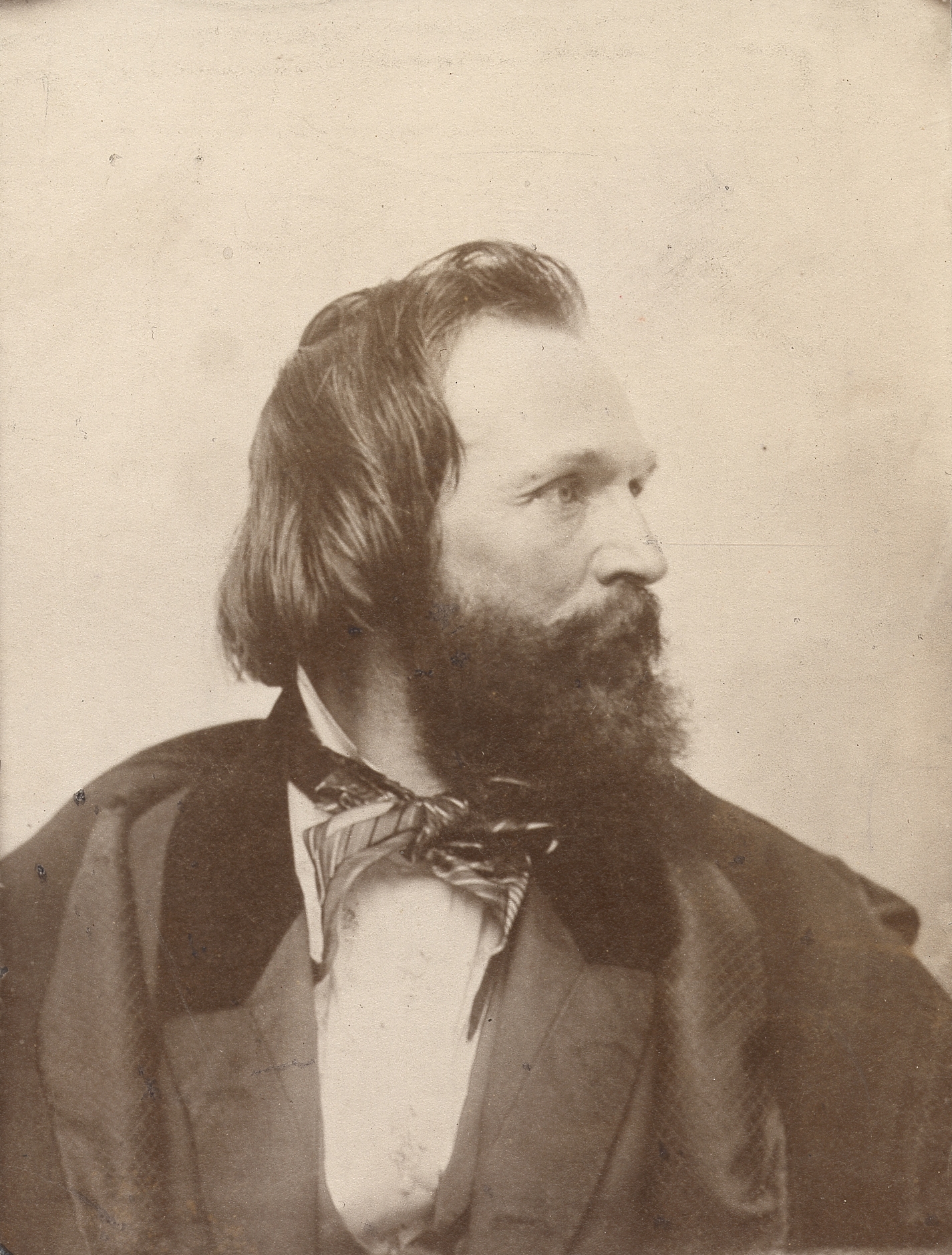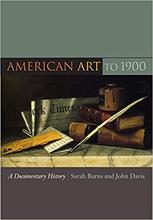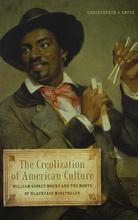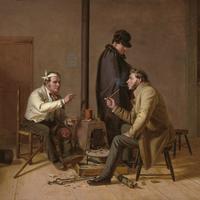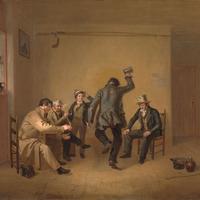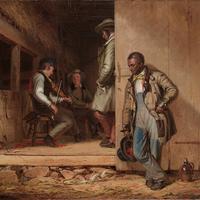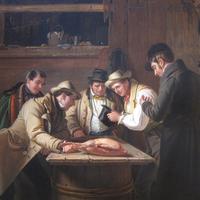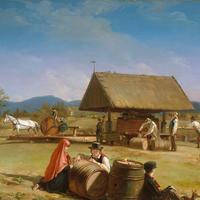More about William Sidney Mount
- All
- Info
- Shop
Works by William Sidney Mount

Sr. Contributor
William Sidney Mount was not too generous with his personal information when asked by writers and historians; he would often refuse to respond to their requests for material.
What he did do, however, was write many “scribbles” and autobiographical outlines about himself in private journals. Much of the biographical information, as well as his thoughts on painting and artistic practices, that we have come from his journals, letters, and diaries, of which over four thousand pages exist today. He may have thought that any long-winded explanations of his work were unnecessary, simply because he believed his paintings to be straight-forward depictions of American life.
Mount is recognized as being one of America’s greatest genre painters, but he had an inauspicious start to his career. He began working at the age of 17 as an apprentice sign-painter alongside his brother Henry in New York City. Painting signs wasn’t doing it for him though, so he enrolled at the then recently opened National Academy of Design, also in New York. His other brother, Shepherd Alonzo Mount, would also go on to become an artist, although he would never be as popular or successful as William.
Mount painted his first portrait, of himself, in 1828, and completed his first “other” subject later that same year with Christ Raising the Daughter of Jairus. His early work is a long way from the very detailed scenes of American life that he would later create; it wasn’t bad by any means, but he was still finding his way. During the following decade, Mount really began to come into his own and he would produce some of his most well-known paintings between the 1830s and 1840s, Farmers Nooning and Cider Making among them.
If all Mount did was paint iconic scenes of daily life, that would be enough for most artists, but Mount was a little different; he was also into music, and inventing stuff. His interest in music shows itself in a number of his works, such as The Power of Music at the Cleveland Museum of Art, and the two different versions of The Banjo Player, one featuring a Black musician, and the other a white one. One of his inventions even combined music with art, when he built and patented the "hollow back violin" (it was concave on the back), which he named the Cradle of Harmony. Other inventions included a two-hulled sailboat, a steamboat paddle wheel, and a painting studio on wheels that he probably used for some of his preliminary outdoor sketches.
There’s another little quirk that Mount had: for a few years, he was involved as a participant in seances, and claimed to have been touched by spirits on more than one occasion. He also said that he had two letters dictated to him by none other than Dutch master Rembrandt van Rijn. An interest in the occult became kind of trendy among some Americans during the mid-1850s, as did posthumous portraits, often of children, which is kind of creepy, but helped pay the bills.
Mount kept a “spiritualist diary” where he recorded his experiences with seances and the spirits. During one sitting, he heard “raps and scratching” and felt his legs and feet being touched, while an umbrella was taken from him and given to another participant. At another seance, a letter was written by six different spirits with the bonus of a sketch (colored in by Mount), while the table moved the whole time. As for the letters from the spirit of Rembrandt, which are quite wordy, he speaks of his models, colors, costumes, lighting, painting styles, even the “nationalism” of his work, something which he had in common with Mount. We don’t know if Mount really believed that Rembrandt spoke to him through a medium, or if he thought it was a clever way of getting his thoughts on aesthetics and processes across. Either way, I can see why he might not want to share these particular experiences with random journalists.
Sources
- Caldwell, John, Rodriguez Oswaldo Roque, Dale T. Johnson, and Kathleen Luhrs. American Paintings in the Metropolitan Museum of Art. New York: The Metropolitan Museum of Art, 1994.
- Cowdrey, Mary Bartlett, and Hermann W. Williams. William Sidney Mount: 1807-1868. An American Painter. With a Foreword by Harry B. Wehle. New York: Columbia Univ. Pr., 1945.
- Frankenstein, Alfred V., and William Sidney Mount. Painter of Rural America: William Sidney Mount, 1807-1868. Washington, D.C.: Printed by H.K. Press, 1968.
- Kusserow, Karl. "William Sidney Mount: Painter of American Life." The Journal of American History 87, no. 1 (2000): 172-77. doi:10.2307/2567922.
- Mann, Maybelle. "Francis William Edmonds: Mammon and Art." American Art Journal 2, no. 2 (1970): 92-106. doi:10.2307/1593900.
- “Mount ‘Hollow Back Violin.’” National Museum of American History. https://americanhistory.si.edu/collections/search/object/nmah_605654.
- Mount, William Sidney, and Alfred Victor Frankenstein. William Sydney Mount. New York: Abrams, 1975.
- “National Gallery of Art.” Artist Info William Sidney Mount. https://www.nga.gov/collection/artist-info.1741.html
- Weinberg, H. Barbara, and Carrie Rebora Barratt. American Stories: Paintings of Everyday Life, 1765-1915. New Haven, CT: Yale University Press, 2009.
Featured Content
Here is what Wikipedia says about William Sidney Mount
William Sidney Mount (November 26, 1807 – November 19, 1868) was a 19th-century American genre painter. Born in Setauket, New York in 1807, Mount spent much of his life in his hometown and the adjacent village of Stony Brook, where he painted portraits, landscapes, and scenes inspired by daily life from the 1820s until his death in 1868 at the age of sixty. During that time he achieved fame in the U.S. and Europe as a painter who chronicled rural life on Long Island. He was the first native-born American artist to specialize in genre painting. Mount was also passionate about music and a fiddle player, a composer and collector of songs, symphonies, sonatas and other works, and designed and patented several versions of his own violin which he named the "Cradle of Harmony." Many of his paintings also feature musicians and groups of people engaged in dance in rural settings.
Check out the full Wikipedia article about William Sidney Mount

